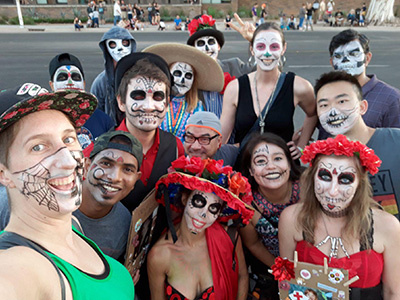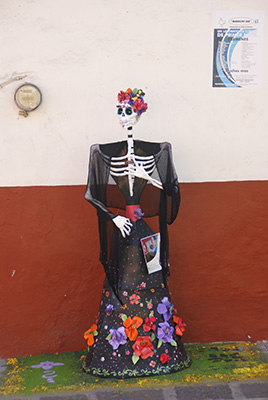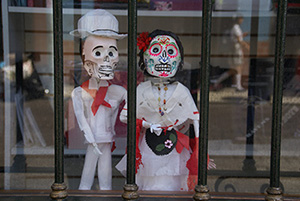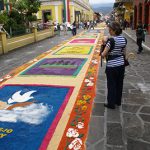Dia de los Muertos
Dia de los Muertos has come and gone this year, my first, and I am only eight months old.
Dad pointed out my first catrina to me and said, “Scary, very scary.”
Mom said, “Catrinas are not scary, very scary.” imitating dad. “This is not Halloween. Mexicans celebrate the dead. This is not “Night of the Living Dead”, this is Dia de los Muertos!” She seemed mad at dad.
Mom was right of course. Catrinas and catrínes are not scary, they are beautiful. I smile at them just like I do at the living — the living who insist on communicating with me by making smacking noises with their lips. Perhaps, they are the ones that are dead?
Though I think we need to forgive dad, which is often the case. Not to make excuses, but Dad grew up watching moves like “Night of the Living Dead”, the original one; the one mom mentioned — not the remake.
For both dad and myself, this was our first time in Mexico during Dia de los Muertos celebrations. Never mind, it was my first time in Mexico. Come to think of it, I have been in Mexico longer than anywhere else except my Mom’s belly and even some of that time was in Mexico. Wait, that means this isn’t the first time I’ve been in Mexico! The point is that It, Dia de los Muertos, was all new to us; dad and me.
Learning about all my relatives
As if Dia de los Muertos didn’t make things interesting enough, Mom and Dad had visitors from the United States of America. I wasn’t sure why they had visitors from there since they don’t seem to like the leader so much. Dad is always saying he, the leader, is very scary, but not the same way he said the Catrinas were very scary; and mom never corrects him like she did with the Catrinas.
They kept calling the visitors the donor and the donor’s mother. I think they had something to do with how I got here and the petri dish. Mom and dad liked them a lot and the visitors seemed to like mom and dad a lot. And of course, I would be remiss if I didn’t mention that I was the centre of everyone’s attention.
The donor and her mother played with me a lot. I liked the donor with her beautiful smile and very long hair. I got to grab it a lot and pull. She didn’t seem to mind like when I pull the hair on my dad’s chest. The donor’s mother was also very nice. She kept looking at me and then the donor. Sometimes she looked at me like mom looks at me.
We went everywhere together. We walked around Coatepec to see Catrinas and Catrínes and then traveled to Naolinco and XIco. I think Naolinco was the best. There was a very big celebration there with the largest Catrina in the world, much bigger than dad.
In Naolinco we visited the graveyard where people were bringing food, drink and other items to the graveside of their loved ones. Mom says you are suppose to bring things that the dead person liked.
Meanwhile, everyone decided that we should make an altar honouring dead people we knew and loved. There are altars everywhere in Mexico during Dia de los Muertos. Like at the graves, we put things that the dead people liked when they were alive. We had cigarettes, tequila, muffins, sugar skulls (dad ate most of them) and even a piece of bacon for a dog (which dad did not eat!). It was really pretty and when it was finished, mom and dad told me that most of the people in the pictures were related to me in one way or ano
How lucky am I?
Very is the only answer I can think of. Why if it wasn’t for the donors; mom and dad, and all the people responsible for the donors; mom and dad being here, I wouldn’t be here. Now that I am here, I see that my presence makes an awful lot of people happy. I don’t mean all the people who smile at me on the street because they think I am cute or very white, not sure which! I mean all the people, even though I haven’t done anything big yet, who are rooting for me. I am going to root for them too (dead and alive), because I think I am very lucky to be part of something much bigger than me.
My aunt writes a postscript
My aunt read this post and raved about how good it was. Then complained that it had no historical context. Some adults are like that. She said she was going to write an article for the RockyPoint Times. She did and I asked if I could publish a selection of it here. She said I could. Imagine I am not even a year old and I am respecting copyright. Hope it lasts. Here is what my aunt has to say about Day of the Dead.
 Day of the Dead is now a mixture of pre-Hispanic heritage, Catholic religion, humor, and reverence for the departed. Lately the Catrinas have become increasingly popular, and Catrin and Catrina contests are popping up everywhere. Mexico has towns that are designated “Magic towns”. Coatepec Veracruz, where my daughter was born and most of my family resides is one such magic town. Now this magic town is brimming with representations of the Catrinas. They are not just in the “Magic towns” but rather, they are everywhere in the country, in parties; shops; costume contests; arts and crafts etc. but few people know where the Catrina comes from.
Day of the Dead is now a mixture of pre-Hispanic heritage, Catholic religion, humor, and reverence for the departed. Lately the Catrinas have become increasingly popular, and Catrin and Catrina contests are popping up everywhere. Mexico has towns that are designated “Magic towns”. Coatepec Veracruz, where my daughter was born and most of my family resides is one such magic town. Now this magic town is brimming with representations of the Catrinas. They are not just in the “Magic towns” but rather, they are everywhere in the country, in parties; shops; costume contests; arts and crafts etc. but few people know where the Catrina comes from.
It was Jose Guadalupe Posada, a cartoonist, that first came up with the Catrina. Diego Riviera named it, and painted the most famous Catrina in a mural in Mexico City.
The Catrina is a very elegant woman with European clothes because the original depiction mocked the rich land owners of the time that liked everything European, and however elegant her clothes might be, in death we will all be the same.
Posada was a political cartoonist. Many people saw his drawings and did not know how to read at the time. The drawings from Posada made them understand his concepts with no need for words. In this manner the Catrina was born in 1910. However, Posada’s possible inspiration far outdates the Catrina. The possible inspirations, Day of the Dead celebration and Mictecacihuatl, goddess of death and Lady of Mictlan are possibly thousands of years old.
The pre-Hispanic tradition is to make altars with everything that the deceased liked because on that day, their spirit will return to be with the family; in a fun way, a family reunion, with drinks and food. Music is also present and everything you would have for family reunion. This reunion just has some living and some that passed.
Another important characteristic of this day is recognizing everyone’s mortality. A traditional “Calavera” is a poem made for someone who still lives but in the form of an epitaph. They’re usually short funny and clever poems. The important people in an office, like the boss or public figure cannot escape this day without a “Calavera” written about them. The poem is witty and sometimes political. Posada was also a master of these short witty Poems. He used them many times to make fun of the rich, the business owner, the politicians, the famous or anyone he could make rhyme and bring out laughter from his growing public. Always ending in the way, the person is now just another skull, always reminding us in the end rich or poor we will all be the same.
Another reminder of our mortality lies on the famous sugar skulls. They’re not just pretty candy with bright colored frostings and sweet decorations. Many times, they have the name of the living family members printed on them.
In Mexico we play with the idea of being dead. We eat the idea of the dead, sweet and rewarding. We remember the ones that are already dead, coexist with them and think about the prospect of being dead. This is done in a fun mocking way. We talk about the lady death taking us with her, not crying, not dreading. We make fun, daring her sometimes to come and get us on the Day of the Dead. In a true Mexican way just celebrating. It’s another opportunity to dance, sing, drink and eat our favorite food, while we still can!
This acceptance of death, our mortality and the ephemeral nature of life is something that would do much good to other countries. Maybe accepting death and not fearing it so much would make it easier for not just the people who are close to being “on the other side” but also for the people who love them, so they can be more accepting of their passing.





Average Rating